Global Meteorological Drought: A Synthesis of Current Understanding with a Focus on SST Drivers of Precipitation Deficits
Submitter: S. Schubert
Reference:
Schubert, S., R. Stewart, H. Wang, M. Barlow, E. Berbery, W. Cai, M. Hoerling, K. Kanikicharla, R. Koster, B. Lyon, A. Mariotti, C. Mechoso, O. Müller, B. Rodriguez-Fonseca, R. Seager, S. Seneviratne, L. Zhang and T. Zhou, 2016. J. Climate, Vol. 29, No. 11, doi:10.1175/JCLI-D-15-0452.1.
Abstract:
Drought affects virtually every region of the world, and potential shifts in its character in a changing climate are a major concern. This article presents a synthesis of current understanding of meteorological drought, with a focus on the large-scale controls on precipitation afforded by sea surface temperature (SST) anomalies, land surface feedbacks and radiative forcings. The synthesis is primarily based on regionally focused articles submitted to the Global Drought Information System (GDIS) collection together with new results from a suite of atmospheric general circulation model experiments intended to integrate those studies into a coherent view of drought worldwide. On interannual time scales, the preeminence of the El Niño Southern Oscillation (ENSO) as a driver of meteorological drought throughout much of the Americas, eastern Asia, Australia and the Maritime Continent is now well established, whereas in other regions (e.g., Europe, Africa and India), the response to ENSO is more ephemeral or non-existent. Northern Eurasia, central Europe and central and eastern Canada stand out as regions with few SST-forced impacts on precipitation on interannual time scales. Decadal changes in SST appear to be a major factor in the occurrence of long-term drought, as highlighted by apparent impacts on precipitation of the late 1990s “climate shifts” in the Pacific and Atlantic SST. Key remaining research challenges include: (i) better quantification of unforced and forced atmospheric variability as well as land and atmosphere feedbacks; (ii) better understanding of the physical basis for the leading modes of climate variability and their predictability; and (iii) quantification of the relative contributions of internal decadal SST variability and forced climate change to long-term drought.


